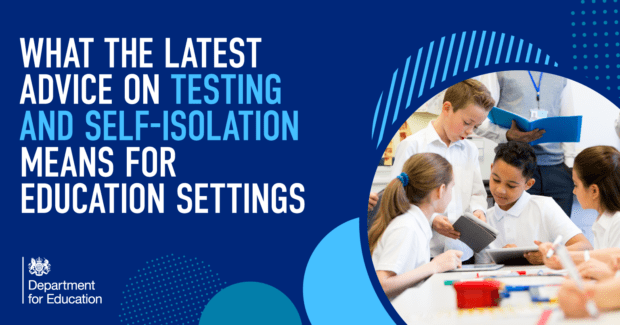
This article contains out of date information about Covid-19 in schools. We no longer recommend routine testing. Please visit this link for up-to-date information.
On Monday 21 February, the Prime Minister announced the removal of measures put in place during the COVID-19 pandemic as we learn to live with the virus. This includes changes for schools and colleges such as no longer recommending regular testing for pupils and staff without symptoms and removing the legal requirement for people to isolate following a positive test - this includes school pupils, further education and higher education students and all staff in mainstream education and childcare settings.
Here is what you need to know and what this means for education settings.
Testing
The latest changes to testing rules do not mean the end of testing altogether. Regular testing is still advised for specialist special educational needs and disability (SEND) settings, alternative provision, and SEND units in mainstream schools or the equivalent in colleges.
All settings may be advised by their local public health team to recommend lateral flow device (LFD) tests to manage an outbreak.
What if staff or students want to continue testing regularly?
Although this will no longer be recommended, staff in education and childcare settings and students and pupils can still access test kits by ordering them online or through their local pharmacy if they wish.
Self-isolation
From 24 February, the Government will remove the legal requirement to self-isolate following a positive test. In addition, the Government will no longer ask fully vaccinated close contacts and those aged under 18 to test daily for 7 days and routine contact tracing will end.
Adults and children who test positive will continue to be advised to stay at home and avoid contact with other people for at least 5 full days and then continue to follow the guidance until they have received 2 negative test results on consecutive days.
Staff, children and young people who are contacts should attend their education settings as usual. This includes staff who have been in close contact within their household, unless they are able to work from home.
The UK Health Security Agency (UKHSA) published updated guidance on 24 February.
Should parents send their child to school if they think they have COVID-19?
If a child has any of the main symptoms or a positive test result, the public health advice remains unchanged and is to stay at home and avoid contact with other people.
Anyone with any of the main COVID-19 symptoms should order a test and is advised to stay at home while waiting for the result.
If they test positive, they are advised to follow public health advice.
Why have you made these changes?
At present, the Omicron variant of COVID-19 is the dominant strain. Following the latest public health advice, we know that Omicron presents low risk to most children, young people and fully vaccinated adults.
Most people will only experience mild or asymptomatic illness (meaning they show no symptoms at all), which combined with our successful vaccination programme and its high rate of take-up, allows us to bring the education testing regime in line with wider society and bring greater normality back into the school day.
Throughout the pandemic, we have adapted the measures in place in schools to strike the balance between protecting education and reducing transmission.
It remains our absolute priority to do everything we can to protect students in face-to-face education.
The measures we recommend in education settings, such as encouraging vaccine take up, hygiene or ventilation measures, are always based on the latest scientific advice.
How can you continue to prevent the spread of COVID-19 across education settings?
Good ventilation, hygiene and encouraging vaccination uptake, as well as following any additional advice from local directors of public health, are the best measures to prevent the spread of COVID-19 in education settings.
Ventilation
We have provided over 360,000 carbon dioxide (CO2) monitors to all state-funded education settings, including early years, schools, and further education providers, backed by £25 million. The new monitors enable staff to identify areas where ventilation needs to be improved and provide reassurance that existing ventilation measures are working, helping balance the need for good ventilation with keeping classrooms warm.
Many classrooms and communal areas in schools are already well-ventilated, and we have also made up to 9,000 high efficiency particulate air (HEPA) cleaning units available for the small number of settings where poor ventilation cannot be quickly rectified.
Vaccination
Vaccines remain our best weapon against this virus. By getting vaccinated, children and young people can increase their protection against COVID-19.
Being vaccinated minimises the need for children and young people to have time-off school and college and helps them to continue to carry out their hobbies, attend social events and live their lives to the full. It therefore supports their emotional wellbeing and happiness.
While most children infected usually have mild symptoms from COVID-19 some may go on to develop more serious symptoms. Doctors are still learning about these long-term effects but we know that vaccination helps to protect against these risks.
More information the latest COVID-19 advice is available on: COVID-19 Response: Living with COVID-19 - GOV.UK (www.gov.uk).